Morris & Fan. Reservoir Sedimentation Handbook
Подождите немного. Документ загружается.

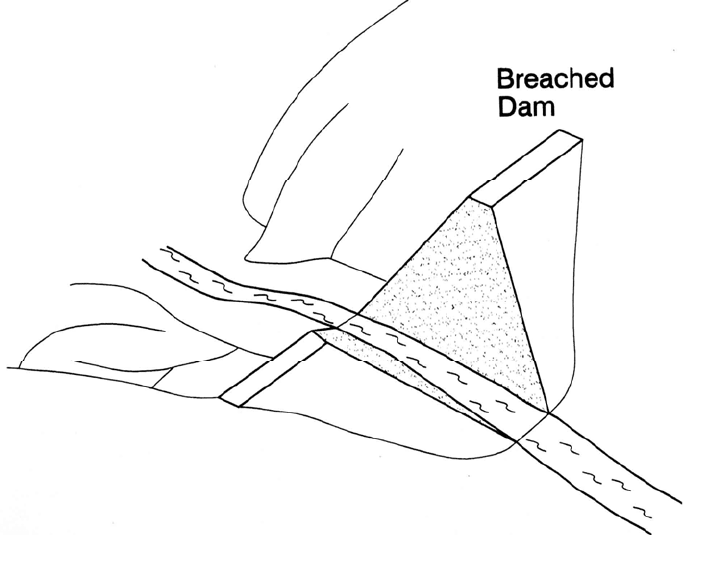
DECOMMISSIONING OF DAMS 17.4
FIGURE 17.2 Partial breaching of a dam.
lo
cation. The duration of the darn removal process will depend on the size and
complexity of the structure, but may require only a few months for smaller dams.
Figure 17.3 illustrates complete dam removal.
17.2.4 Staged Breaching
Staged breaching can be used with either partial or complete removal of a dam, and
entails the gradual lowering of the crest of the dam over a period of time until the final
intended geometry is achieved. The total duration of the staged removal may be months
or years, and the time step between drawdown stages will depend on factors including
the volume of sediment deposits and the rate they can be removed. If frequent high-
discharge floods occur, and the volume of sediment that must be removed is relatively
small and easily eroded, then the duration between successive stages can be short. If the
flood discharges are low, the sediment volume to be removed is large, and the sediment
is difficult to erode, the duration between successive stages may be longer. The rate of
lowering will often depend on the rate at which the downstream channel can accept the
sediment load, and particularly the limitations imposed by the downstream river channel
morphology, infrastructure, ecosystems, and other factors sensitive to increased sediment
loading. Staged breaching or removal is well-suited to the gradual release of sediment
downstream by natural erosion.
Staged breaching can be implemented on a variety of dam structure types, but is
riskier when applied to earth embankment dams as opposed to more robust structures,
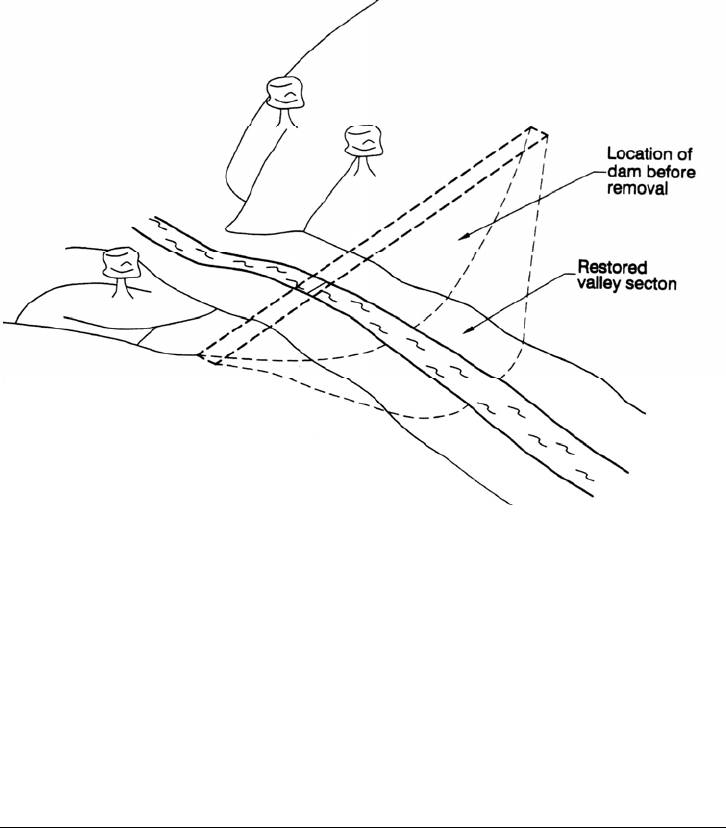
DECOMMISSIONING OF DAMS 17.5
FIGURE 17.3 Complete dam removal.
s
uch as concrete dams. Figure 17.4 is a schematic illustration of the staged removal
process. When staged removal of a dam is applied to earth embankment dams, armoring
of the crest or inclusion of an auxiliary spillway may be required for the duration of the
project. Should no auxiliary spillway be provided, flows will discharge over the crest
of the structure, exposing it to the erosive power of the water and potentially creating a
dam safety hazard due to embankment failure. Armoring of the crest may be required to
safeguard against such events.
17.3 SEDIMENT MANAGEMENT OPTIONS
There are four basic sediment management options. Some of these options can be
combined in a single project. For example, it may be feasible to allow part of the
sediment to erode naturally during the initial phases of the decommissioning project, with
channeling and stabilization being implemented during the later phases. Another option
might be to allow natural erosion to occur in the early phases of a project, with complete
removal of sediment taking place during the last phase. Selection of the optimal strategy
will depend on factors including cost, potential for downstream flooding due to sediment
release, impact to downstream infrastructure, water quality, and other
environmental considerations. The sediment management options outlined below are by
no means exhaustive. Unique project conditions may lead to the use of innovative
techniques, which may or may not be a combination of the options outlined below.
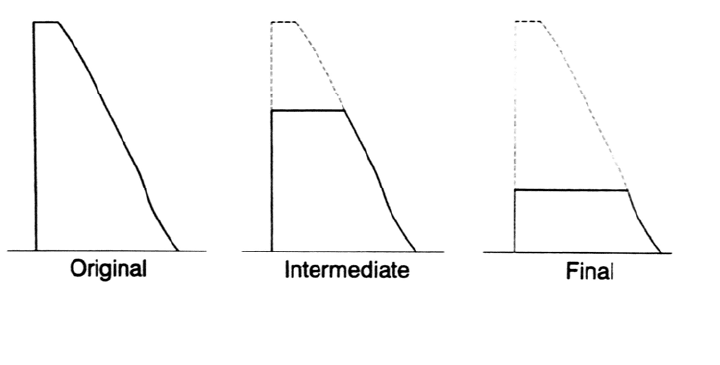
DECOMMISSIONING OF DAMS 17.6
17.3.1 Leave Sediment in Place
FIGURE 17.4 Staged removal of a dam structure, in section view.
If it is feasible to leave the dam in place, the option of also leaving the sediment in place
may be the cheapest solution, at least initially. Nondisturbance of the sediments has the
important advantage of avoiding the release of a large sediment volume to the
environment downstream of the dam. In some cases it may also be desired to leave
sediments in place due to the presence of pollutants, or concerns that removal of
contaminated sediment from a reservoir and disposal to an upland site could generate
leachate that might contaminate groundwater.
To leave sediments in place it is necessary that they not be scoured and remobilized
by the river system, implying that areas of sediment deposition continue to be
impounded and that the dam remains in place. Sediments may remain trapped upstream
of a dam using a partial breaching which lowers but does not empty the pool.
Predominantly coarse material within the dewatered upstream part of the pool may be
eroded and transported closer to the dam, prograding over and burying finer sediment
deposits in deeper areas of the pool near the dam. However, if the reservoir is breached to
the level of the original thalweg, significant erosion of sediment will occur. Attempts to
leave the sediment in place during partial or complete removal of a dam are not likely to
be successful if the lowered pool level allows scouring velocities to be generated in the
area of deposits, unless the channel is artificially armored or lined.
If sediment inflow and outflow are nearly balanced before decommissioning, there
may be little additional long-term impact from leaving the dam in place. However, if
this balance has not been achieved and the dam remains in place, then sediments will
continue to accumulate and can potentially generate adverse long-term consequences
because of aggradation upstream of the dam, deposition against the structure, and
continued degradation of the reach below the dam due to the interruption in sediment
supply. From the standpoint of sediment management, in general it is desirable to undertake
decommissioning in a manner that accelerates the reestablishment of the sediment
balance across the impounded reach, instead of continuously accumulating sediment
which may create future problems, and which only further delays the reestablishment of
the natural sediment regime along the river.
The long-term response of the fluvial system can be investigated with empirical
methods or computer modeling. The investigation commences by establishing sediment
characteristics, estimating sediment yield, and simulating sediment transport. Simple
empirical approaches to estimate the ability of the reservoir to retain sediment as a
function of storage capacity and inflow were developed by Brune (1953) and Churchill
DECOMMISSIONING OF DAMS 17.7
(1948). An empirical method for distributing the trapped sediment within the
impoundment was developed by Borland and Miller (1958) and is applicable to deposits
below the maximum pool level. The method presented by Annandale (1987) can also
analyze backwater deposits above the maximum pool level. The selection of the
numerical modeling approach will depend on the nature of the problem.
17.3.2 Natural Erosion
Natural erosion can occur when a dam is either partially or completely removed; it is
conceptually similar to the creation of a flushing channel by the permanent drawdown of
the pool. This sediment management option can be combined with other techniques. For
example, the first phase of the project may entail removal of sediment by natural erosion,
followed by channel stabilization during phase 2 of the project.
Natural erosion has the potential advantage of low initial cost, but needs to be
executed in a controlled manner. Uncontrolled erosion may produce adverse conditions
in river reaches below the dam. Erosion of fines can produce a wide range of adverse
downstream environmental consequences, and the release of large volumes of coarse
sediment can infill downstream channels and cause problems such as flooding and
impairment of navigation. The savings achieved at the reservoir by using natural erosion
need to be balanced against the costs that may be experienced downstream because of the
increased sediment loading.
An alternative approach is to control sediment release by removing the dam in
stages, lowering the dam crest elevation by stages to allow sediment deposits to be
eroded and discharged downstream in an incremental manner. The objective is to
develop a chronology of staged breaching that will limit the rate of sediment release to
satisfy environmental and other downstream restrictions. The process of staged dam
removal continues in steps until the final elevation has been achieved or free flow
through the river system has been reestablished, depending on the project objectives.
When staged dam removal is used, the staging should be developed to cause natural
erosion during floods having a relative high frequency (short return interval).
Natural erosion will not remove all the sediment from a reservoir, even with
complete dam removal, and in a heavily sedimented, shallow, wide reservoir, natural
erosion may remove only a small part of the total deposit. Conversely, in a narrow river or
gorge-type reservoir, natural erosion can remove most of the sediment. The lowered
water level within the reservoir that results from lowering the dam crest will create a
channel-floodplain configuration in areas of sediment deposition, but unlike flushing,
lowering the crest will permanently expose previously deposited sediments.
Revegetation will help stabilize and dewater these deposits, and the sediment deposits in
these stabilized and vegetated floodplains will remain in place and will not be eroded and
transported downstream.
The rate of dam lowering and sediment release will be determined by rate-limiting
processes within the reservoir, such as the inflow and erodibility of deposits, plus the
rate of sediment release that can be tolerated by downstream aquatic ecosystems or
infrastructure. Because both the amount and characteristics (e.g., grain size, erodibility)
of the deposits vary as a function of elevation within the impounded area, each stage of
the dam breaching process will not necessarily proceed at the same rate. Progress may
also be influenced by hydrologic conditions such as flood or drought, or other unknowns
which cause the rate of sediment release to depart from predictions.
Development of a sediment management plan that uses the concept of natural
erosion will require field investigation to determine transport and entrainment
characteristics of the deposits. Field information may be systematically analyzed by
DECOMMISSIONING OF DAMS 17.8
computer simulation of the intended plan. Computer models such as HEC-6,
FLUVIAL-12 and GSTARS that have the ability to simulate the scour and deposition of
sediment can be helpful in the evaluation of potential management plans. Models such as
these can help evaluate and compare various staged dam removal strategies, the cross-
sectional shape of the dam crest during each successive phase of dam removal, and the
timing of each consecutive stage of dam crest lowering. A stochastic approach based on
historical hydrologic sequences that may be modified for this purpose is presented by
Annandale (1996). However, experience with dam removal is quite limited, and methods
of predicting the rate of retrogressive erosion under a dam removal scenario are far from
precise. Significant departure from predicted conditions should be anticipated unless field
trials are conducted or there is experience from a similar site to work from.
17.3.3 Channeling and Stabilization
Sediment management by channeling and stabilization may be used concurrently with the
partial breaching and complete dam removal options, or as the last phase of a staged dam
removal process. The objective is to leave a significant amount of the sediment in the
reservoir pool, passing flow through a stabilized channel that will not erode the deposits. The
procedure is to first drain the reservoir, partially breach or completely remove the dam,
and excavate a channel through the sediment deposits upstream of the dam. Because
erosion of the deposits will begin as soon as the pool is lowered, dredging may be used to
evacuate the channel prior to or during pool lowering to minimize sediment release.
Excavated sediments may be discharged to an upland disposal site, or may be discharged to
another portion of the reservoir where they will be stabilized and protected against future
erosion.
Channel design is a key element to this sediment management strategy, and the design
criteria will depend on the conditions specific at each project. Since the objective of
decommissioning is to abandon the project insofar as possible, a primary design objective
is to provide a channel configuration that will either be stable in the long run or evolve
into an acceptable configuration in a short time as sediment inflow and outflow come into
balance across the previously impounded river reach. The development of a suitable
sediment balance along any channel design is critical to the long-term success of this
strategy. In general, the best option is to redevelop a "natural" channel configuration
through the deposits, using channel widths and slopes which produce a stable channel
configuration, thereby minimizing or eliminating the need for costly bank stabilization.
If the dam is removed, the channel would normally be reestablished along the original
stream thalweg. However, since sediment deposits are deepest along the thalweg, this option
may also result in the removal of large volumes of sediment. In the case of partial dam
removal, a portion of the pool area near the dam may continue to be impounded after
decommissioning, and a new channel planform may be developed across the area near the
dam. This planform may be developed by channeling if the pool is lowered to the point
that deposits are exposed, or it may develop naturally as the remaining pool fills with
sediment in areas where the original deposits continue to be submerged. In the case of
partial breaching, the breach would normally be located to discharge into the existing
downstream channel, even though a new channel planform may be developed in the still-
impounded reach above the dam.
A major objective of decommissioning is to return the fluvial system to a self-
maintaining natural condition. This implies the use of environmental design approaches
which seek to restore natural stream geometry, including the development of streambank
configurations that enhance the potential for the growth of stabilizing riparian vegetation and
which encourages overbank flooding which nurtures riparian wetlands. The channel
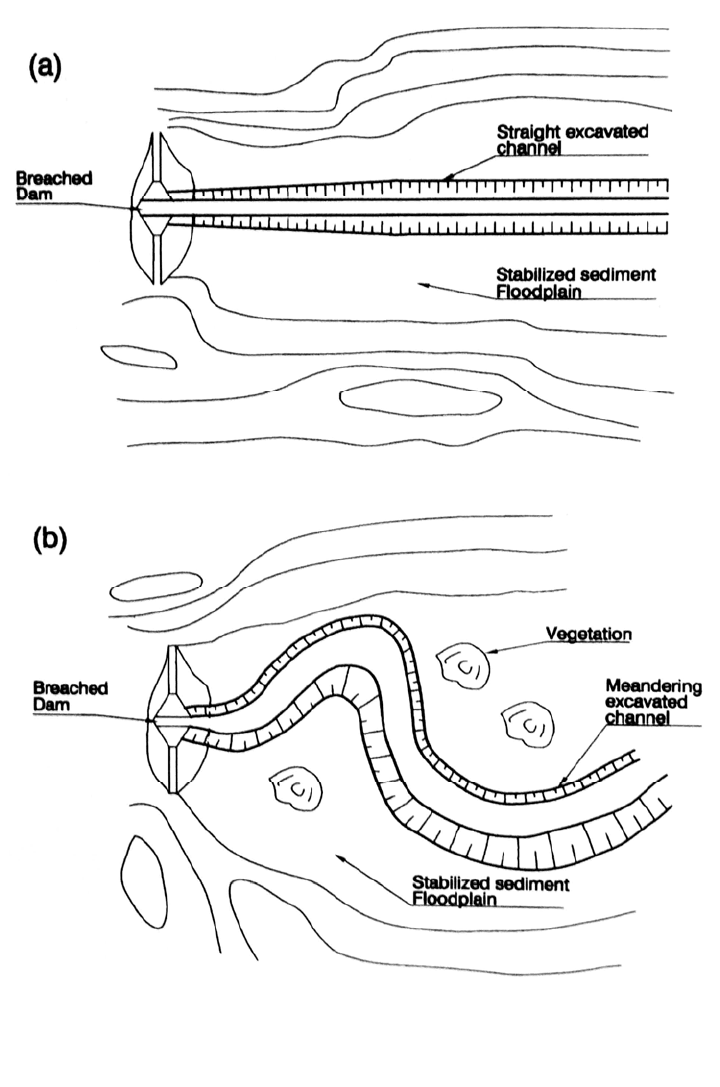
DECOMMISSIONING OF DAMS 17.9
layout will represent a meandering stream, possibly with a gravel bed and planted bank
vegetation to provide shade, food supply, and habitat. This approach contrasts sharply
with the conventional engineering approach involving the design of a straight flood channel
to pass floods downstream as quickly as possible. However, in some cases the traditional
design approach may be suitable. Both design options are schematically illustrated in Fig.
17.5.
FIGURE 17.5 (a) Conventional engineered channel through sediment deposits. (b)
Natural channel design through sediment deposits.

DECOMMISSIONING OF DAMS 17.10
It may be necessary to stabilize the channel banks using either conventional
stabilization techniques, such as riprap, or bioengineering approaches. The choice of
suitable stabilization techniques will depend on the nature of the deposits, and, in
poorly consolidated deposits near the dam, the use of conventional materials such
as riprap may not be feasible. The floodplain sediments on either side of the
channel may also benefit from vegetative stabilization by seeding with grasses or
tree planting.
Another channeling and stabilization option is to keep the darn in place and route the
river around it. This may be a feasible option in cases where the darn and reservoir are
located in an oxbow. The bypass channel around Nagel Darn in South Africa for the
purpose of sediment bypass is shown in Fig. 13.9. This same strategy may be used to
bypass flow around a structure that is to be decommissioned, leaving the darn and
sediments in place.
17.3.4 Complete Removal of Sediment
Complete removal of sediment from a reservoir to be decommissioned can be per-
formed by either conventional earth moving techniques or hydraulic dredging (Chap. 16).
Conventional excavation takes place in the dry and requires that the reservoir
be drained and sediments dewatered sufficiently for access and handling before
excavation begins. The sediment is then removed with conventional equipment such
as dozers and front-end loaders, and loaded onto trucks or conveyers for transport
to the disposal site. The viability of the approach is a function of the time it takes
for the sediment to dry, the availability of disposal sites, the quality of the
sediment, and the possibility of draining the reservoir. Because sediments will be
eroded downstream while the reservoir is emptied (as in flushing), environmental
restrictions may limit the possibility of draining the reservoir, or may require
draining and excavation by phases. If contaminants have collected to the point that
the sediment is considered a hazardous material, special handling and disposal
measures will be required.
Mechanical dredging with a clamshell or dragline can be conducted without
dewatering the reservoir, but is best suited for coarse sediment and relatively small
impoundments; it is poorly suited for the handling of fines. For the removal of large
volumes of sediment that is sand-size or smaller, hydraulic dredging will generally be the
preferred option. The dredging system will typically consist of a barge-mounted
pumping unit, suction line with a cutterhead, and a discharge line extending to the
disposal area. The disposal area consists of a diked holding pond in which the
sediment is allowed to settle, and the clear supernatant water is then discharged
back into the environment (Fig. 16.3). The settled material can be either left in
place or hauled to the final disposal site.
17.4 DECISION FACTORS
Many cost, legal, and environmental factors enter into decisions pertaining to the
feasibility of decommissioning a dam. They include water and sediment quality and
impacts on the fluvial system, existing infrastructure, flood management, ecological,
and social issues.
17.4.1 Water and Sediment Quality
Pollutants from both point and nonpoint sources can be sorbed onto sediment particles,
particularly fines, and deposited in reservoirs as the sediment accumulates.
DECOMMISSIONING OF DAMS 17.11
Contaminants may include agricultural chemicals such as pesticides, runoff or point-
source discharge from upstream industrial areas which may contain heavy metals or toxic
organic compounds, products from mine drainage or tailings, or products from
industrial or other spills. Some constituents may not be classified as toxins, but
nevertheless may have extremely deleterious effects on downstream ecosystems,
such as sediment containing high nutrient levels or organics which will exert a
significant oxygen demand.
Contaminants immobilized within reservoir sediments may not have a deleterious
impact on the water quality discharged downstream of reservoirs as long as the sediments
are not disturbed. This is particularly true of older sediments, which may contain
toxic substances (such as pesticides) that are no longer being discharged to the
environment, and which have become entombed beneath more recent clean sediments.
Dam removal may mobilize these contaminated sediments.
Should the sediments contain unacceptable concentrations of pollutants, such
as those on the U.S. Environmental Protection Agency Priority Pollutant List, or
should the sediments be classified as hazardous material, it may be more costly, more
harmful to the environment, or both, to decommission in a manner that disturbs and
remobilizes the contaminated sediments. Testing of sediments through the entire
depth of the deposit to be disturbed should be undertaken for contents such as heavy
metals (arsenic, beryllium, cadmium, zinc, etc.); volatile solids (acrolein, bromoform,
benzene, etc.); base/neutral compounds (acenaphthene, benzidene, chrysene. etc.);
acidic compounds (4-chloro-3-methylphenol, phenol, etc.); and pesticides (Aldrin,
Chlordane, etc.). To better define the chemical composition of the sediment, it is
also common to test for total Kjeldahl nitrogen, nutrient level, and total organic
carbon. The toxicity characteristics leaching procedure (TCLP) can be used to
determine whether the sediment has the potential for contaminants to leach out.
The type and levels of contaminants in the sediments, together with the characteristics
and sensitivity of the downstream areas that would be affected by sediment release,
will play an important role in determining whether it is feasible to decommission
by either partial or complete removal of the structure in a manner that mobilizes
sediment. Should dam removal be required despite presence of problem sediments,
the sediment properties will play a major role in determining the dam removal and
sediment management strategy.
In reservoirs that trap fine suspended sediments, darn removal will impact the
turbidity downstream. A temporary increase in turbidity will occur while the new channel
is being established through the reservoir, and a long-term increase in turbidity will occur
as a result of eliminating the sediment-trapping function previously provided by the
dam. Elimination of storage above the dam will also affect the streamflow and
temperature budget of the stream, with the direction and magnitude of this change
being highly site specific.
An increase in downstream turbidity can impact the entire aquatic food chain by
shading primary producers, smothering benthos, clogging spawning gravels, and
heavily affecting filter feeders. Changes in visibility affect the ability of sight
predators to detect their prey, which can significantly alter the structure of the
biological community, favoring some species and potentially eliminating others. Dam
construction can also change a turbid warm-water stream into a clear cold-water
stream, as in the case of the Colorado River below Lake Powell where the predam
water temperature range was 0° to 28°C and the postdam temperature range is 8° to
9°C. This change had a significant impact on the aquatic life in the river, leading to the
establishment of a new ecosystem. After the stream ecosystem and society (especially
anglers and recreational boaters) become adjusted to clear-water conditions, a change back
to natural but turbid conditions may be considered undesirable. In many other areas, clear-
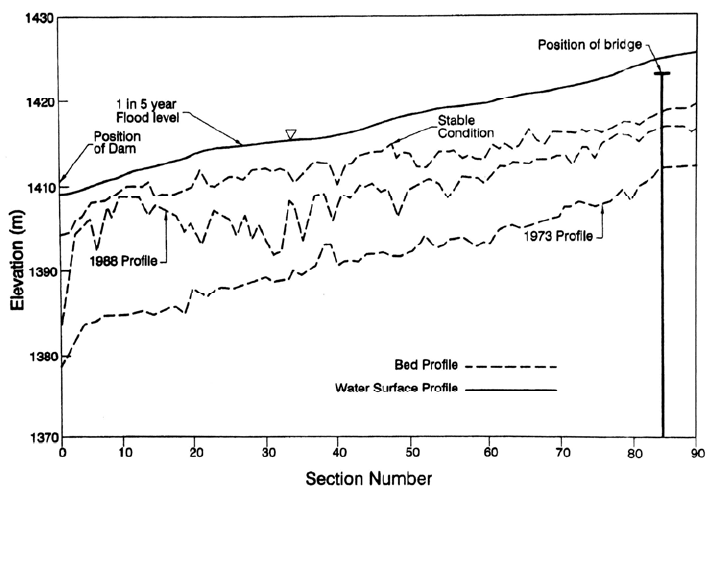
DECOMMISSIONING OF DAMS 17.12
water conditions may occur naturally, but increased sediment loads have occurred
because of disturbance and accelerated erosion in upstream watersheds. The main-
tenance of downstream aquatic or marine ecosystems that rely on clear-water conditions
may depend on continued sediment trapping by the dam, and dam removal would subject
the downstream ecosystems to turbidity stress.
Prediction of the impact of turbidity and temperature changes on aquatic life and
habitat is a complicated issue: positive impacts on certain species may have negative
impacts on others. Biological assessment, modeling, and monitoring of the affected
reach may be required, and biological impacts may be an important parameter in
selecting the optimal mix of potential decommissioning actions.
17.4.2 Fluvial Morphology
Dam decommissioning can affect the morphology of the fluvial system both upstream
and downstream of the reservoir. If the dam is not removed and sediments remain in
place, the pattern of long-term sediment accumulation will continue until a full sediment
balance is achieved across the impounded reach. Not only will continued sediment
deposition eventually fill the reservoir pool, but it can also cause significant deposition
above the pool level, thereby creating problems such as increased upstream flood levels
and waterlogging of riparian soils as the streambed is progressively elevated by continued
deposition. The extent of deposition above the maximum normal level can be significant.
An example of sediment deposition above the full supply level is presented in Fig. 17.6,
which shows profiles for the original river bed and subsequent sediment deposits
upstream of Welbedacht Dam along the impounded reach of the Caledon River, on the
border between the Kingdom of Lesotho and the Republic of South Africa. The high rate
of sediment discharge into this reservoir led to rapid loss of capacity. The large sediment
volumes deposited above the full supply elevation of the reservoir led to frequent over-
FIGURE 17.6 Sediment deposition upstream of Welbedacht Dam, South Africa.
DECOMMISSIONING OF DAMS 17.13
topping of a bridge structure located approximately 25 km upstream of the dam,
and frequent flooding in the town of Wepener located on a tributary to the Caledon
River. Conversely, the partial or complete removal of the dam will lower the base
level for the stream above the dam, potentially causing erosion to extend above the
pool level.
Impacts to the river below the dam can be severe, especially when the dam is partially
or completely removed and sediments are released to the downstream channel. The
magnitude and duration of the impacts will depend on the sediment volume released
relative to the transport capacity in the river. Fine sediment released to a high-
gradient stream may have a large initial impact in terms of water quality, but if the
sediment deposits are quickly eroded from the reservoir and the fines are rapidly flushed
out of the downstream channel, the impact will be short-lived. However, coarse
material is typically flushed through a river system at a much slower rate, and sandy
sediment released by dam removal may be transported along the downstream channel
as a slow-moving sediment wave. Observations of fluvial behavior of rivers below dams
which have failed indicate that sediment can require many years to move through the
river system. The sand wave released by removal of the Newaygo Dam on the
Muskegon River, Michigan (Simons and Simons, 1991) moved downstream a distance
of about 14 km during the first 9 years, and an estimated 50 to 80 years will be
required for the sediment slug that was released from this dam to be flushed through
the river system. The downstream impacts of sediment release can be reduced by
channelization or staged dam removal, respectively, to lessen the total volume or the
rate of sediment release to the downstream channel.
The slow downstream migration of a sand wave or slug can produce a variety
of problems in the river system including channel changes, impairment of navigation,
elevation of the river bed and flood levels, and blockage of tributaries. The greatest
reduction in the cross-sectional area of the stream occurs at the apex of the sand
dune, with less influence at other locations. If a sand bar is stable for sufficient time
for brush and small trees to grow, the sand can become trapped in the channel and flood
levels can rise due to reduced channel capacity plus increased channel friction due to
the vegetation. If sufficient sediment is released, the increased sediment load can alter
the river planform, causing meandering and braiding or more frequent lateral
movement of the river. Any marked acceleration of lateral migration attributable
to dam removal can become a costly problem in areas where riverbank property,
infrastructure, or bridge crossings are affected and require protection. Elimination of
reservoir storage may increase downstream flood peaks, which will tend to
increase the sediment transport capacity below the former dam site and accelerate
channel erosion processes.
17.4.3 Existing Infrastructure
Movement of a sand wave through a river system, and its associated effects on river
morphology, can also have an impact on existing infrastructure. The infrastructure
most likely to be affected include bridges, water intakes, outfalls, and navigation
channels. Bridges can be affected by an increase in the stream bed elevation due to
the release of coarse sediment from the previously impounded area, decreasing both
flood conveyance capacity and navigational clearance beneath the structure.
17.4.4 Flood Management
The impact of dam decommissioning on flood management depends on the selected dam
removal and sediment management options. Should the decommissioning plan call
for the dam and sediment to remain in place, the owner might be required to staff the
